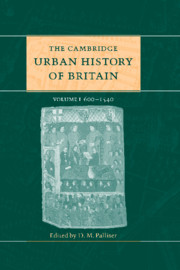Book contents
- Frontmatter
- Part I Introductory
- Part II The early middle ages 600–1300
- 3 General survey 600–1300
- 4 Power and authority 600–1300
- 5 Society and population 600–1300
- 6 The economy of British towns 600–1300
- 7 Churches, education and literacy in towns 600–1300
- 8 The topography of towns 600–1300
- 9 London from the post-Roman period to 1300
- 10 The large towns 600–1300
- 11 Small towns 600–1270
- Part III The later middle ages 1300–1540
- Part IV Regional surveys
- Part V Conclusion
- Appendix: Ranking lists of English medieval towns
- Select bibliography
- Index
- References
9 - London from the post-Roman period to 1300
from Part II - The early middle ages 600–1300
Published online by Cambridge University Press: 28 March 2008
- Frontmatter
- Part I Introductory
- Part II The early middle ages 600–1300
- 3 General survey 600–1300
- 4 Power and authority 600–1300
- 5 Society and population 600–1300
- 6 The economy of British towns 600–1300
- 7 Churches, education and literacy in towns 600–1300
- 8 The topography of towns 600–1300
- 9 London from the post-Roman period to 1300
- 10 The large towns 600–1300
- 11 Small towns 600–1270
- Part III The later middle ages 1300–1540
- Part IV Regional surveys
- Part V Conclusion
- Appendix: Ranking lists of English medieval towns
- Select bibliography
- Index
- References
Summary
the early settlement 400–900
In the late fourth century London, formerly one of the most substantial Roman cities north of the Alps, was the prime seat of authority in Britain and still a significant centre of urban life. Within a generation or two, following the withdrawal of imperial rule, the city had been virtually abandoned. Yet later London owes much to its Roman predecessor. The carefully constructed site on the Thames, the bridge at the hub of an extensive road network and the ready access to a productive hinterland and to the river networks and markets of northern Europe endowed London with continuing potential as a place for business. The circuit of walls was to shape the city for centuries to come. Features within the walls, surviving as enclosures or as barriers to movement, influenced later settlement and may have marked seats of authority (Plate 3). During the fifth and sixth centuries this largely uninhabited site perhaps served as a focus for a zone of settlements within some twenty miles (32 km). London persisted as a massive, but ruined, physical presence and as an idea in bureaucratic memory. Perhaps the most important element in the city's continuity is ideological: in the recognition of its power as the organising principle for a distinctive territory.
London comes more clearly into view in 601, when Pope Gregory envisaged that it would serve as the primatial see of England. Political reality no longer matched Roman perceptions and London, in the province of the East Saxons, was under the overlordship of the king of Kent.
- Type
- Chapter
- Information
- The Cambridge Urban History of Britain , pp. 187 - 216Publisher: Cambridge University PressPrint publication year: 2000
References
- 8
- Cited by



